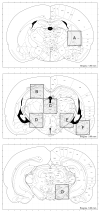Biodistribution and safety assessment of AAV2-GAD following intrasubthalamic injection in the rat
- PMID: 20352617
- PMCID: PMC2896684
- DOI: 10.1002/jgm.1449
Biodistribution and safety assessment of AAV2-GAD following intrasubthalamic injection in the rat
Abstract
Background: The steps necessary to translate promising new biological therapies to the clinic are poorly documented. For gene therapy, there are unique aspects that need to be addressed in biodistribution studies. Notably, the spread of the vector beyond the intended target cells or tissue may result in persistent unwanted biological activity or unpredictable biological events; thus, it is critical to evaluate the risks associated with viral vector-mediated gene transfer prior to embarking on human clinical trials.
Methods: In the present study, we conducted a comprehensive assessment of vector biodistribution throughout the brain, blood and major organs of rats that had been injected via the subthalamic nucleus with recombinant adeno-associated virus (AAV) expressing glutamic acid decarboxylase (GAD). In addition, behavioral and histological analyses were also performed.
Results: AAV genomes were not detected in blood or cerebrospinal fluid, and did not disseminate to organs outside of the brain in the majority of animals. In the brain, an average of 97.3% of AAV2-GAD genomes were restricted to the area of the ipsilateral subthalamic nucleus (STN). There were no discernable effects of AAV2-GAD on general health, and a behavioral assessment of the animals did not reveal any alteration in general behavior, exploration, locomotion or motor symmetry.
Conclusions: The present study met Food and Drug Administration requirements, in addition to efficacy and toxicity studies in rodents and nonhuman primates, to support and supplement a Phase II clinical trial invloving the gene transfer of AAV2-GAD to the human STN for the potential therapy of Parkinson's disease.
References
-
- Kordower JH, Herzog CD, Dass B, et al. Delivery of neurturin by AAV2 (CERE-120)-mediated gene transfer provides structural and functional neuroprotection and neurorestoration in MPTP-treated monkeys. Ann Neurol. 2006;60:706–15. - PubMed
-
- Gasmi M, Herzog CD, Brandon EP, et al. Striatal Delivery of Neurturin by CERE-120, an AAV2 Vector for the Treatment of Dopaminergic Neuron Degeneration in Parkinson’s Disease. Mol Ther. 2007;15:62–8. - PubMed
-
- Herzog CD, Dass B, Holden JE, et al. Striatal delivery of CERE-120, an AAV2 vector encoding human neurturin, enhances activity of the dopaminergic nigrostriatal system in aged monkeys. Mov Disord. 2007;22:1124–32. - PubMed
-
- Bankiewicz KS, Forsayeth J, Eberling JL, et al. Long-term clinical improvement in MPTP-lesioned primates after gene therapy with AAV-hAADC. Mol Ther. 2006;14:564–70. - PubMed
Publication types
MeSH terms
Substances
Grants and funding
LinkOut - more resources
Full Text Sources
Medical
Miscellaneous





